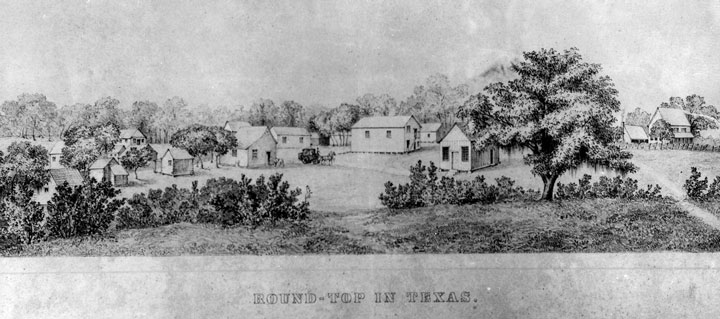
These brief histories were written by members of the Fayette County Historical Commission. They first appeared in the weekly column, "Footprints of Fayette," which is published in the Fayette County Record, Banner Press, Flatonia Argus, Schulenburg Sticker, and Weimar Mercury newspapers. A new article appears weekly. See index of all Footprints of Fayette articles.
By Neale Rabensburg

The panorama of “Round Top in Texas” is a lithograph depicting the mid-19th Century village of Round Top on Cummins Creek located in northeastern Fayette County. This townscape was made prior to the American Civil War on or about 1857. [1]
Unfortunately, the artist for this lithograph was forgotten and has remained an unknown up until recently. The original drawing for this lithograph has never surfaced but could possibly exist in a private family collection. Several lithographs of the Round Top panorama were probably made and, fortunately, one of these survived and came into the possession of Mr. John G. Banik, who had been a principal and teacher for the Round Top school system and taught English in La Grange, the county seat. The Houston Post newspaper published an article on June 30, 1963 on the Round Top Fourth of July Celebration and featured photographs including Banik’s panorama of “Round Top in Texas".[2] Banik later donated his “old etching” to the Festival Hill Institute near Round Top during the 1970s. [3]
In May 2018, Dr. James C. Kearney, who is a professor with the Department of Germanic Studies at the University of Texas, contacted amateur historian, Neale Rabensburg, about the panorama of “Round Top in Texas”. Rabensburg noted that he was familiar with this artwork but not with the artist. However, he was able to identify for Kearney several of the buildings and indicated that two were still standing. Kearney was trying to determine if Conrad Caspar Rordorf, the Adelsverein artist, was responsible for the panorama. Rabensburg indicated that the probable date for this lithograph was about 1857, which would be ten years following Rordorf’s tragic death during the “Shoot-out” at nearby Nassau Plantation. Thus, it was determined that Rordorf could not be the artist for the panorama. [4]
Kearney introduced Rabensburg to Dr. Ron Tyler, who is a professor of history at the University of Texas and the former Director of the Amon Carter Museum of American Art in Fort Worth. Tyler had also been the Director of the Texas State Historical Association and the Center for Studies in Texas History at the University of Texas at Austin, where he edited the Southwestern Historical Quarterly and The New Handbook of Texas. Tyler was preparing a document on early Texas lithographs and was familiar with the panorama of “Round Top in Texas”. [5]
During his conversations with Tyler and Kearney as well as other interested historians, Rabensburg made an educated guess that the artist for the panorama of “Round Top in Texas” might be William von Rosenberg, Sr. (William), who had been a Royal Architect for the King of Prussia in Berlin prior to his 1849 immigration to Texas and Fayette County. Rabensburg based his opinion on a comparison with another drawing by William, which was Eckitten Estate (1849) in East Prussia. Rabensburg found similarities between the two drawings and shared his findings with Tyler, Kearney and Jon Todd Koenig, who is the President of the Historians for the von Rosenberg Family of Texas. Koenig and Tyler both concluded that the panorama of “Round Top in Texas” was indeed drawn by William von Rosenberg, Sr. Koenig submitted additional William drawings for support, and these included the Sans Souci Palaces in Potsdam, Prussia, and a depiction of the earlier, stone-faced State Capitol Building in Austin, Texas. Tyler furnished the panorama of the “City of Austin” also drawn by William. [6]
It is interesting to note that the large live oak tree laden with Spanish moss and centered in the panorama of “Round Top in Texas” still stands today 160 years later. The tree dominates the landscape and is considered by its present owner to be the one of the largest live oaks in Fayette County. It remains verdant and healthy year after year even during droughts since a nearby spring feeds its massive root system. The hanging Spanish moss, however, no longer exists, and has been replaced on many Fayette County trees, unfortunately, with the invasive ball moss.
William von Rosenberg, Sr., lived in northeastern Fayette County south of Nassau Plantation, which was the home of his parents, Peter Carl Johann and Amanda Fallier von Rosenberg. William moved his family in 1856 to Austin where he joined the Texas General Land Office and became its chief delineator and map maker. He returned to Fayette County on visits and made area survey drawings and prepared the building documents for one of the earlier Fayette County Court Houses. [7]
Rabensburg also determined that the land speculator, Edward Henkel, probably sponsored the panorama of “Round Top in Texas” and hired William von Rosenberg, Sr., as the artist to promote the emerging village of Round Top on Cummins Creek and his own acreage for sale within that community. [8] The view of the panorama is taken from the “hill” south of present-day Henkel Square. William’s drawing, as a publicity image, may have prompted his parents to buy a one-acre lot on Henkel’s “hill” on March 3, 1859, where a town home was built on or about 1860. Henkel’s connection to the panorama is more plausible since his own home has been prominently displayed on the far right of this lithograph.
by Gesine (Tschiedel) Koether
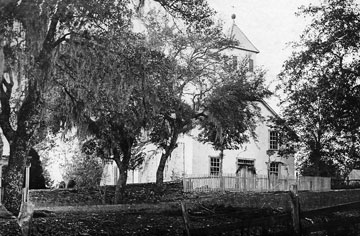 Just like many of us in Fayette County we have parents, grandparents, great-grandparents, etc. who were baptized, confirmed, married and buried here in Fayette County Texas. Being proud of my roots and fortunate enough to have some of my ancestors’ baptism, confirmation and marriage certificates from Bethlehem Lutheran Church of Round Top, Texas, it made me wonder just why, how and when did Bethlehem Lutheran Church begin.
Just like many of us in Fayette County we have parents, grandparents, great-grandparents, etc. who were baptized, confirmed, married and buried here in Fayette County Texas. Being proud of my roots and fortunate enough to have some of my ancestors’ baptism, confirmation and marriage certificates from Bethlehem Lutheran Church of Round Top, Texas, it made me wonder just why, how and when did Bethlehem Lutheran Church begin.
With the help of the book “Our God is Marching On”, a centennial history of the Bethlehem Lutheran Church written in the 1960s by Reverend Martin H. Obst, John G. Banik and other contributors, many of my questions were answered. The Lutheran Church is the oldest Protestant Christian tradition, dating back to the Protestant Reformation and the person, Martin Luther, whose childhood, university studies and time as an Augustinian monk were spent searching for religious understanding. He believed that he found enough problems in the world and church to make significant changes. Rebelling against many of the rules made by the authorities, he nailed the 95 Theses to the Castle Church in 1517, resulting in some strong reactions and the beginning of the Protestant Reformation in Germany. This movement, which spread, believed in recognizing the rights of individuals to follow their own personal convictions.
By the early 1800s, many Germans became restless with the lack of opportunity to make a decent living, that they had no voice in choosing the men who governed them and with the constant quarrels between the rulers requiring military service that took the lives of their sons. All of these concerns, as well as the advance of education and belief that Americans had declared that all men are free and equal, helped many families including Friederich Ernst to board ships from Germany heading for America - “the land of milk and honey”. In the early 1830s, Friederich Ernst, his wife and ten-year old daughter arrived in America and settled in Industry, Texas. They are believed to be some of the first Lutherans, but it is difficult to say just who, when and where the first Lutherans settled. What we do know is that Friederich Ernst did write letters inviting other Germans to come and many did. The settlements spread up Mill Creek and over the divide to the Cummins Creek watershed. Letters from other families and friends in this land must have inspired a strong faith in those willing to risk everything to head to this new place to live.
Immigrants came from many places in Europe, but Stephen F. Austin was known to have encouraged the Germans and Swiss to come. Many of these settled in the Round Top area once called Townsend. It is believed that as early as 1855 early Lutheran pastors started organizing the Lutherans in Round Top. We know that Carl Siegismund Bauer (1792-1873) from Annaberg Sachsen, Germany planned and directed the building of the Bethlehem church with the help of his two sons, Carl Ehrgott Bauer (1828-1869) and Carl Traugott Bauer (1830-1869), and son-in-law Conrad Schueddemagen (1811-1900). In fact, Conrad and Wilhelmine Schueddemagen’s house was also planned and built by the Carl Bauer.
The history of Bethlehem Lutheran Church begins with Conrad and Wilhelmine Schueddemagen selling both the land for the church and the cemetery to the church’s congregation in 1865. The native limestone used to build the church cost $2400 and was covered by free will offerings and paid off in only a few years. Many items were donated such as a heater, altar covering, pulpit and bells. It took two men to ring both the little and large bells at the same time for services. They were also rung when a member of the congregation died. Locally grown cedar was used to hand build the pipe organ in the balcony, which was donated by Traugott Wandke. There are 408 pipes and 51 keys. It was dedicated in 1867 and is still being played at church services and other special occasions, although the foot pump has been replaced by an electronic blower.
The church was dedicated October 28, 1866 and continues with an active congregation. This article just scratches the surface of all the dedication and hard work it took to make Bethlehem the church it is today. So many pastors, families, members and others contributed so much to make this church a success. It is nice to continue what my ancestors started back in 1848 with their settling in Fayette County, Texas. My search will continue for other evidence of what Fayette County and I have in common and hope to let you know what find.by Donna Green
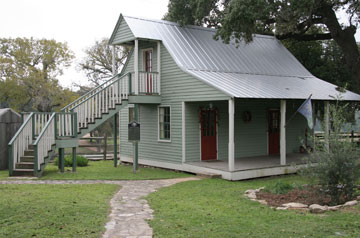 Charles Schiege and his family immigrated to Fayette County, from Hanover Germany in the early 1870's.
Charles Schiege and his family immigrated to Fayette County, from Hanover Germany in the early 1870's.
In the town of Round Top stands a picturesque house and grounds just off of Washington Street. Charles Schiege Jr. built the house along with a small building behind the house that was home to his thriving business, the Schiege Cigar Factory.
Charles Jr’s cigar factory was built in 1882 and it continued to operate until the 1930's. During the years that he operated the factory he used tobacco grown in the area as well as tobacco brought in from Missouri and Ohio. The tobacco was carefully hand-rolled into cigars and distributed to San Antonio, Houston and Austin. Schiege's products carried colorful names such as "Texas Star", "Great Sport", "LaRosa Suprema" and the most popular, "Boss". In 1932 special 50th Anniversary boxes of the "Boss" cigars were put out by the Schiege Cigar Factory. The wooden boxes had the words "light" and "mild" in Spanish stamped on the side. The boxes also carried the dates 1882-1932 on them and featured a photograph of Charles Schiege on the box tops.
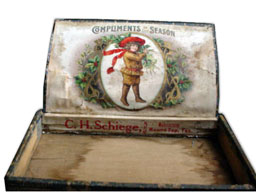 Remarkably the building where Schiege made his cigars still stands. It is a one-story frame building of native lumber. Inside the factory the fixtures consisted of a curved counter separating the working area from the office. Huge tobacco bins held raw cigar materials. At the height of his business seven workstations were attached to the walls for operators. Schiege provided on-site accommodations for his employees. Single men slept in the attic of his house. There were no stairs leading to the attic, so the workers had to climb a ladder to their quarters. The employees ate their meals with the Schiege family. A sign over the factory doorway read "Segars and Tobacco". "Segars" was a standard spelling of the word in the nineteenth century. Today most of the buildings in his complex bear historical markers.
Remarkably the building where Schiege made his cigars still stands. It is a one-story frame building of native lumber. Inside the factory the fixtures consisted of a curved counter separating the working area from the office. Huge tobacco bins held raw cigar materials. At the height of his business seven workstations were attached to the walls for operators. Schiege provided on-site accommodations for his employees. Single men slept in the attic of his house. There were no stairs leading to the attic, so the workers had to climb a ladder to their quarters. The employees ate their meals with the Schiege family. A sign over the factory doorway read "Segars and Tobacco". "Segars" was a standard spelling of the word in the nineteenth century. Today most of the buildings in his complex bear historical markers.
In a 1985 article in the La Grange Journal, Charles Schiege’s daughter, Mrs. Frieda Schiege Franke, related a story of how she and her brother would sneak into the factory and learn how to make cigars from the workers. At the time of the article she still owned many pieces from the factory including specially made cigar cutters.
Charles was also a cabinetmaker and served as a justice of the peace. Schiege died in March 1935 and is buried at Florida Chapel Cemetery.
By David L. Collins, Sr.
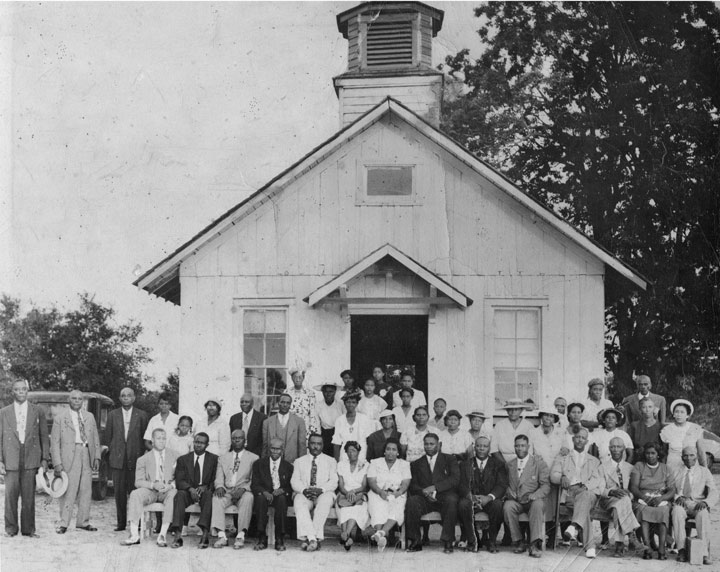 The Concord Baptist has been an active African American Church in Round Top, Texas, since its founding in 1867 with a charter membership of 186. Its rich history is recorded in the historical records of the La Grange Baptist District Association Historical Album published in 1993. A review of some of the original church attendance records by longtime church member Maude Cole shows that the attendance in the first month in 1927 was 14. The highest in 1927 was 27; 45 on October 13, 1928; 47 on June 29, 1929; and 48 in one month in 1931. At a special gathering in the summer of 1932, there were 117 members in attendance. Over the years its membership declined due to the fact that so many African Americans eventually left the Round Top area to find farms or livelihood elsewhere, primarily Lee County.
The Concord Baptist has been an active African American Church in Round Top, Texas, since its founding in 1867 with a charter membership of 186. Its rich history is recorded in the historical records of the La Grange Baptist District Association Historical Album published in 1993. A review of some of the original church attendance records by longtime church member Maude Cole shows that the attendance in the first month in 1927 was 14. The highest in 1927 was 27; 45 on October 13, 1928; 47 on June 29, 1929; and 48 in one month in 1931. At a special gathering in the summer of 1932, there were 117 members in attendance. Over the years its membership declined due to the fact that so many African Americans eventually left the Round Top area to find farms or livelihood elsewhere, primarily Lee County.
Arch Leonard, Thomas Rivers, and Adam Rivers paid a sum of $100.00, received in hand by J. C. Benford, Thomas Shelby, and Jerry Crawford, Trustees of the Round Top Missionary Baptist Concord Church, in the Town of Round Top (James Winn League) for two (2) acres of land on the east side of Highway 237 on December 20, 1892.
Based on information from Georgia Tubbs and from her conversation with James Dobbins, Ollie Jones and Perline Knotts-Burrell, the church had two singing groups in the 1930s - the “Standard Four”, consisting of Ferris Cole (bass), Lufkin Shelby, Loraine Cole and Arizona Shelby. The other group was the “Royal Four” with James Dobbins (lead tenor), Eddie Jones, Charlie Daniels and Van James. The latter group was still in existence when the Round Top Area Historical Society was founded in 1993. These groups sang/performed at the Round Top church and also rendered programs for neighboring churches.
Some of the pastors of Concord included Rev. Sidney Grant; Rev. A. N. Bass; Rev. White, Rector; Rev. John Simmons, Reverends Goins, McNeil and Hubbard, plus Rev. T.R. Simmons and Rev. C. D. Ray. Some of the early members/families of the church were William Craft, Seth Banks, Ben and Thuney Knotts, Charles Lovings, Charlotte Phenix, William Cole, Professor Hollins, Emily Harris, Sergie Martin, Smith Sampson, Al Leonard, Shed Williams, Wash Wade, Mae Cole, Addie Benford, Walter Moore, Hezekiah McCoy, Mr. Vincent, Mrs. Lucia Rhone and Oscar and Julane Knotts.
Some of the church members were educators in the Round Top School System, including C. L. Rhone, a Colored School teacher in 1900, who was the father of Urissa Rhone-Brown, who taught in the school system for many years. She retired in 1976. Other Round Top faculty, who were church members, included Iva Lee Rhone Tanner, Weldon Knotts, Sarah Simpson and Pearline Knotts-Burrell.
My great uncle Matt Rivers, Jr. was a long time member of Concord until his death in 1955; he is buried in the Connersville Primitive Baptist Church Cemetery on FM 1457, directly behind the Richter Cemetery. The Concord Church did not have its own cemetery, so many of its members were buried at the Connersville Primitive Baptist Church Cemetery or elsewhere.
James Walter Dobbins, my cousin, was another longtime member until he died in 2005 at the age of 105, having lived his entire life in Fayette County. He and his wife would wear bright red matching suits on special Sunday occasions. James Dobbins would always tell me when we met that Matt Rivers was a very proud man, who would always ride his great white stallion to town or church.
Clarence Phenix and his family, who were lifetime residents of the Round Top area, were also members of Concord. He was a local auto mechanic in Round Top until his death in 2011 and is also buried in the Connersville Primitive Baptist Church Cemetery. Phenix was one of the few African Americans who did not migrate from the Round Top area.
The church has always been at its present location with minor additions over the years. The success and longevity of the Concord Baptist Church can be attributed to the faithfulness and conscientious efforts of its members from the time of its organization 148 years ago, only two years after Emancipation. Although there are only a few members at present, the congregation continues to preserve the legacy founded by their forefathers.
by David L. Collins, Sr.
Since the beginning of my search for our family history, I have visited many grave sites. This adventure for the true meaning of my African American history has carried me through many cemeteries in Lee County and Fayette County, Texas. The cemeteries in Lee County include Jones Colony, Globe Hill, Salem, Sweet Home, Antioch, Sandy Point, Pilgrim Rest, Post Oak, Sandy Point Church Cemetery, Leo, Copperas, Scott, and several others. The cemeteries in Fayette County include Connersville Primitive Baptist Church and Spring Hill.
These cemeteries were named after communities founded by African Americans, known as Freedom Colonies, which were autonomous settlements founded entirely by freed African American slaves. Many of these settlements continue to thrive today. There were two Freedom Colonies in Fayette County, Texas, brought to my attention by Carolyn Heinsohn of the Fayette County Historical Commission, which include Armstrong Colony and Cozy Corner.
When I found Connersville Cemetery, the first graves I came upon were the graves of L.D. Craft, A. J. Craft, E. C. Craft, Loraine Cole, George Craft, and next to their graves was the grave of Emma Rivers, one of my relatives. The most striking thing about my discovery was the inscription on one of the headstones. The inscription read “In the Back Woods We Lay”, which I thought was rather striking. What came to mind after all the research that I have done is that this is where much of our African American history is at rest and in many cases lost – in the “back woods”.
Sometime between the date of December 10, 1883 and November 10, 1885, when a man by the name of Thomas Cooper owned eleven and one-quarter acres of land adjacent to the “Old School Presbyterian Church and Round Top Academy” land (today the vicinity of Richter Cemetery on FM 1457), he gave permission for the black community to build a church - the Primitive Baptist Church.
Thomas Cooper sold ten and a half acres of land to William Zander (FCDR 26/62) on November 10, 1885. Note that this sale reduces the original acreage by three-quarters of an acre. On September 29, 1893, Thomas Cooper deeded over the land to the Primitive Baptist Church (FCDR 50/242) for $1.00. The deed gives no metes and bounds description, but merely states, “immediately surrounding the present site of the Primitive Baptist Church”. It is not known when the members of the Primitive Baptist Church ceased using the church facilities as there is no known recorded history of this.
 In an apparent desire to build a church, a group of individuals, possibly descendents of earlier ancestry, purchased 65/100 of an acre tract of land from Richard and Hannah Wagner (FCDR 296/492). It is interesting to note that part of this same tract of land was previously owned by the Primitive Baptist Church with no record of it ever being sold. The survey of deed 296/492 indicates a total of 0.65 acres and places it fronting FM 1457 adjacent to Richter Cemetery. This was deeded to the Connersville Primitive Baptist Church on May 20, 1957, for $243.00. The officers to which the deed is given and to be held in trust were J.J. Ferguson, Shelley Ferguson and Beatrice Breedlove.
In an apparent desire to build a church, a group of individuals, possibly descendents of earlier ancestry, purchased 65/100 of an acre tract of land from Richard and Hannah Wagner (FCDR 296/492). It is interesting to note that part of this same tract of land was previously owned by the Primitive Baptist Church with no record of it ever being sold. The survey of deed 296/492 indicates a total of 0.65 acres and places it fronting FM 1457 adjacent to Richter Cemetery. This was deeded to the Connersville Primitive Baptist Church on May 20, 1957, for $243.00. The officers to which the deed is given and to be held in trust were J.J. Ferguson, Shelley Ferguson and Beatrice Breedlove.
J. Joseph Ferguson was pastor of the Connersville Baptist Church. He is interred in the Connersville Primitive Baptist Church Cemetery, which is situated on the same land. One of the earliest graves in the cemetery is George Craft who died on March 1, 1904.
ROUND TOP AREA HISTORICAL SOCIETY
In the late 1990s, I visited every town north of Hwy 71 in Fayette County, starting with La Grange, Texas. I also visited every church and cemetery that I could locate - many of the cemeteries are on private land. As I continued my research, I happened to stop by the Round Top Area Historical Society’s (which was founded May 10, 1993) main office on Hwy 237 to review all of the historical information that the Society had collected. I was amazed by the amount of information the Society had collected over the years. I recall that back in 1997 or 1998, I met Georgia Tubbs, who gave me a complete overview of the history of Round Top, Texas and all of the information the Society had collected over the years. In one corner of the building, she also had some history on African Americans/Educators in the area. Some of the names I had heard about, and some I had not.
During this same visit, I met Mr. Herbert L. Diers, who was Secretary of the Board at the time; his family had settled in La Grange over a 115 years ago. He had been working on Fayette County/Round Top history for many years. He gave me a thorough review of the history he had collected. He also pointed out that he had collected a great deal of history on German settlements, white settlements, and European settlements; however, he did not have much on African Americans, other than what Georgia had collected. We continued to meet over the next several months, and after we got to know each other, he asked me if I would consider being a Board Member of the RTAHS. I indicated that I would let him know in a month. I called him in about two weeks and indicated that it would be a pleasure. This began my relationship with RTAHS.
When I initially joined, the Board the members included: Mrs. Georgia Etzel-Tubbs, Mrs.Francis Harris, Mr. Bobby Banik, Mr. Cordell Levein, Mayor Dave Nagel ( his wife took his place after he passed), Mr. Ronny Sacks, Mrs. Charlotte Hellbolt, Mr. Butler McCauley, Mrs. Pamela Schwartz, Mrs. Barbara Smith, Mr. Herman Weigelt, Mr. Herbert L. Diers, Mr. Gene Menking, Ruth Fricke-Menking, Mrs. Deloise Etzel-McGill, Ms. Dottie Etzel, Mrs. Rose Diers, Mrs.Pat Woods, and several others, which I can’t remember at this time. What I do remember is that all of the original founders of RTAHS were descendents of Fayette County pioneers, dedicated to preserving the interesting history of Fayette County, Texas. One of the Board Members, Mrs. Pat Wood, donated 1.0 acre of land to develop a historical campus for that purpose.
After I was approved to become a Board Member of the Round Top Area Historical Society, Herb Diers, in behalf of the Board, gave me an assignment to assist them in finding someone to give permission to RTAHS to move the old Connersville Primitive Baptist Church to the Wood Annex, as it was called at the time. The Board wanted to develop it into an African American Museum.
This was an easy assignment, because the Moderator was Herman Ferguson who married my Great Uncle David River’s daughter, Juanita Rivers-Ferguson, who lived in Galveston, Texas at the time. She and my Aunt Katie Taylor-Griffin were the best of friends; Katie was my Great-Grandmother’s namesake (Katie Rivers-Taylor, who married my Great-Grandfather, John Wesley Taylor).
MR. HERBERT L. DIERS, FAYETTE COUNTY HISTORIAN
Herb Diers dedicated his life to developing the history of Round Top (Fayette County), Texas along with Georgia Tubbs and the RTAHS Board. He had a vision of a complete historical campus on the land donated by Mrs. Pat Wood. With that in mind, he asked me with the approval of the Board to develop a Master Plan for the Wood Annex.
When I joined the Board there was one building on the Wood Annex site - the Krause House. We walked the site and he indicated that he had a vision of a gazebo in the center, the church on the northeast corner, with other buildings moving toward the front with a parking lot on the south.
With the above in mind, we developed the following:
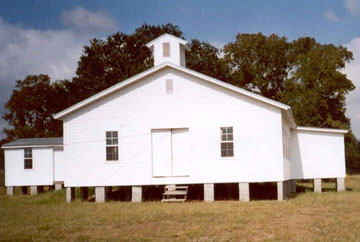 All of this planning resulted in the old church being relocated by the Round Top Area Historical Society in 2002 from its previous location to the graciously-donated Wood Annex in Round Top, Texas and its renovation into an African American Museum. This is how the Connersville Primitive Baptist Church African American Museum began and the rest is history. All of this effort occurred between 1998 and 2008, and today the Carroll A. Wood Museum Complex is fully operational with tours provided to the public.
All of this planning resulted in the old church being relocated by the Round Top Area Historical Society in 2002 from its previous location to the graciously-donated Wood Annex in Round Top, Texas and its renovation into an African American Museum. This is how the Connersville Primitive Baptist Church African American Museum began and the rest is history. All of this effort occurred between 1998 and 2008, and today the Carroll A. Wood Museum Complex is fully operational with tours provided to the public.
During the late 1800's and early 1900's the small community of Round Top was the scene of one of the more interesting sporting events ever to take place in Fayette County. It was known as a "running of the rings" tournament. The event had a medieval theme in which men on horseback competed against each other in a variety of contests. The participants dressed in extravagantly detailed and flashy costumes. Often the costumes reflected the celebration of a particular holiday or were adorned with family crests. The costumes were brightly colored and often featured gold or silver trim with feathers or other decorations. The horses were usually decorated as elaborately as the riders were. The riders had to be expertly trained and skilled. The horses also had to be trained and skilled to work closely with the riders. Spear throwing, lance making, jousting and horse racing were contested throughout the day. However, it was the main event that gave the competition its name and decided the overall winner of the competition. The main event featured competitors using a spear or long lance to snag rings from a target. Those competing in the day's events were referred to as "knights." The "running of the rings" was just part of the celebration that usually began with a parade headed by a Grand Marshall. All the "knights" and their mounts paraded in front of the large crowd of spectators that always gathered. After the events of the day a picnic and dance would be held. According to the La Grange Journal some of the more prominent local citizens known to have participated in the Round Top events were: H. Becker, A. Becker, Fayette County Sheriffs J.T. Rankin and B. L. Zapp (both who served during this time period), K. Neese, Alex von Rosenberg (businessman and land owner), H. Amberg, and J. Robison.
The origins of the celebration remain somewhat of a mystery although several people have researched it. Most researchers agree that the event probably began as an attempt by the large German population to bring some of the culture of their homeland to the area. The area around Round Top was purchased by a German cousin of Queen Victoria and intended to encourage German colonization in Texas. It is likely that the settlers brought this tradition with them when they emigrated.
Transcribed by Connie F. Sneed from the October 4, 1968 Dallas Morning News:
Round Top, Texas - Reviving and bringing to Texas a tradition that began in Munich, Germany in 1810 will be the first annual Oktoberfest Saturday and Sunday. This Texas German community of 124 in Fayette County will present an Antiques Fair and celebration in the Rifle Association Building.
Like the original, it will commemorate the wedding of Prince Ludwig. Along with antique dealers’ booths there will be vignettes with early Texas Pioneer furnishings and a one woman art show by Trudy Sween of Houston, who will present her Fantasy Flowers.
On the grounds will be a German Biergarten and the local German Oompah band will play. Restored buildings in the area open for the Oktoberfest will include Mrs. Hazel Ledbetter’s little “Yellow” house with furniture made in Round Top by early settlers and the Segar factory with some of the original labels and purchase orders for cigars distributed to Southwest Texas.
Hackberry Hill, a complex restored by Mr. and Mrs. Harvin C. Moore of Houston, will also be open for tours.
by Gesine (Tschiedel) Koether
 After years of watching the Science Channel show, “Meteorite Men”, I was excited to find the July 2008 Footprints of Fayette article about the Fayette County Meteorites and Tektites by Carolyn Heinsohn. This article covered details on both the Bluff and Cedar meteorites, but only a brief mention of the Round Top meteorites, as information seemed to be scarce. The mention of the third Round Top specimen being of unknown origin piqued my interest. You see, I knew the story of how our good friend, Lee Roy (aka Sonny) Fricke (1923-2010) had found one of the Round Top specimens. How excited I was to interview his wife, Vera Mae, and son, Tom Fricke, so the details could be added to our historical remembrance of this one meteorite found near Round Top, Texas.
After years of watching the Science Channel show, “Meteorite Men”, I was excited to find the July 2008 Footprints of Fayette article about the Fayette County Meteorites and Tektites by Carolyn Heinsohn. This article covered details on both the Bluff and Cedar meteorites, but only a brief mention of the Round Top meteorites, as information seemed to be scarce. The mention of the third Round Top specimen being of unknown origin piqued my interest. You see, I knew the story of how our good friend, Lee Roy (aka Sonny) Fricke (1923-2010) had found one of the Round Top specimens. How excited I was to interview his wife, Vera Mae, and son, Tom Fricke, so the details could be added to our historical remembrance of this one meteorite found near Round Top, Texas.
Sonny’s family included his father, Fred Fricke Jr. (1886-1955) and mother, Eugenia (Vogelsang) Fricke (1887-1978), who in 1937 were renting a place east of Round Top. Their family included their four sons, Clinton, Fred III, Warren and Lee Roy and daughter, Annie. The late 1930s life was hard and everyone was expected to pull their weight. So one fine day in late 1937 when Sonny’s mom needed wood for her stove for cooking, some of the men of the family set out to get what she needed. Lee Roy was the youngest of the family and at 14 years old raced ahead of the group with their dogs. The family dogs had spotted some squirrels and had just treed them as Sonny jumped over a small branch of the nearby creek. He spotted a strange looking rock so out of place as it was darker in color and much harder than any other rock in the area. Due to its unique appearance, it was brought back to the house for safe keeping and further inspection.
The other Fayette County meteorites had been found late 1800s and early 1900s, so locals knew of their existence. Apparently Oscar E. Monnig had an interest in finding any additional specimens and had been canvassing local farmers in the late 1930s. After word spread of the interest in specimens, Uncle Edgar Fricke Sr. (1897-1948) contacted Monnig for his nephew to see if he was interested in what Sonny had found. According to the family, Mr. O.E. Monnig came in early 1939 to inspect the rock, determined it was a meteorite and paid $57 for the large specimen weighing slightly over 20 pounds. He also took time to visit with the family, allowed the family to view the stars through his telescope and emphasized the importance of these finds as one day man would explore space and the moon.
Per the Meteoritical Society, this specimen was labeled as being found in Round Top proper as this is where Monnig acquired it. In addition, the society found it to be classified as chondrite with olivine Fa18.4 and pyroxene Fs16.1 by H.J. Ehlmann and K.Keil, University of Hawaii, Planetary Geoscience Division, Honolulu, Hawaii in 1993. This find was ultimately donated, along with most of the Monnig collection, to Texas Christian University in Fort Worth. Per the attached photo, it appears the specimen must have been split at some time for perhaps analysis or possible sale as only 7.17 kg (16 pounds) is found on the Meteoritical Society register.
What it must have been like to acquire $57 for a rock back in the 1930s when that took care of many of the needs for the Fricke family. How nice it is that Lee Roy(Sonny) Fricke can finally get credit for this find. However, two questions plague me, did the dogs get the squirrel and did Eugenia get her fire wood? I encourage you to go online to www.fayettecountyhistory.org and lookup the first article on meteorites, and I will continue my search for other interesting historical facts to uncover here in Fayette County Texas.
by David L. Collins, Sr.
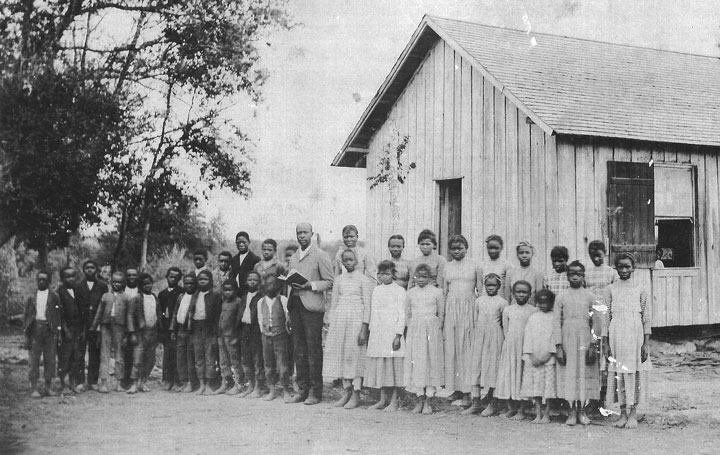
Round Top, Texas is a place where there are many untold stories about African Americans. One such story is about the African American pioneers of that community and their efforts in educating their children after the Civil War. This was done by starting their own church and developing a school.
In 1875, The La Grange Baptist Association had a membership of 58 churches, twenty (20) of which were located in Fayette County, Texas. Many of the churches built their own schools, if not all of them. One such school was the Concord Missionary Baptist Church Colored School, commonly called the Round Top Colored School, that was located next to the Concord Missionary Baptist Church on the east side of Highway 237, just across from the Mercantile Store of Round Top, Texas. It was one of many colored schools that were under the auspices of a county colored school system, which was a separate entity that did not take part in the consolidation of the white schools that mostly occurred in the mid to late 1940s. The Civil Rights Act in 1964 and subsequent desegregation of schools eventually dissolved the colored school system.
The Concord Missionary Baptist Church, an active African American Church in Round Top, was founded in 1867 with a membership of 186. This information is based on historical records of the La Grange Baptist District Association Historical Album published in 1993. By 1900, the census shows that there were 474 African American families living in the Round Top area, so the need for a school was obvious.
Several of the church members were educators in the Round Top Colored School, including Calvin Lindley Rhone (1867-1921), who was a teacher in the 1900s. He and his wife, Lucia J. Knotts-Rhome (1866-1941), were both from highly-regarded African American families who resided in Fayette County for nearly one hundred years. They had 12 children, four of whom were born in Plum, Texas and eight who were born in Round Top. One of their daughters, Urissa Rhone-Brown, taught in the Round Top Colored School for many years until desegregation, when the students were transferred into the Round Top – Carmine Independent School District in 1966. Brown then transitioned into that school district as a teacher and then the Principal of the Round Top Elementary, Junior High and High Schools until she retired in the mid-1970s.
Other faculty members in the Round Top Colored School included Iva Lee Rhone Tanner, Weldon Knotts, Sarah Simpson and Pearline Knotts-Burrell. The only one of these teachers who transitioned into the Round Top – Carmine Independent School District was Pearline Knotts-Burrell. One of her relatives, Madison Knotts, also taught at the Concord Missionary Baptist Church Colored School for several years in the early 1900s. He served as a teacher and principal with 33 students attending the school. One of his prominent students was James Walter Dobbins, who lived in Fayette County his entire life and was a Deacon at the Concord Missionary Baptist Church until his death in 2005 at the age of 105.
Madison Knotts was born in Fayette County in 1884 as a member of the well-known Knotts family of the Round Top area. He attained two years of college education and dedicated years of his life educating African American students, as well as farming and rearing his three children. In 1920, he moved to Carmine, Texas and continued to live there through the 1950s until his death in 1961; he is buried in Giddings, Texas.
The Round Top Colored School, like many other rural colored schools, provided a basic education for a large number of African American youth during the era between the Civil War and desegregation. That education provided the foundation for achievement and advancement in a world beyond the confines of Round Top.
The school photo accompanying this article was taken by Friederike Recknagel, a well-known photographer in Round Top. It was gifted by her grandson, Ed Ahlrich, to Georgia Tubbs, one of the founders of the Round Top Area Historical Society.